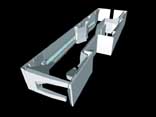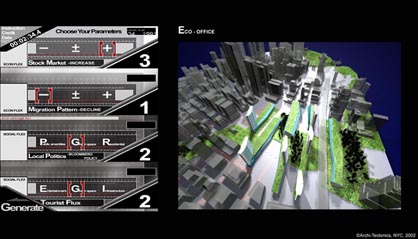|
|
| home |
| On
Winka Dubbeldam Luigi Prestinenza Puglisi |
| [in italiano] |
She is one of the best architects of the moment. Many magazines, such as Architecture, have written about her. You just need to visit her site
(www.archi-tectonics.com)
to find her long list of publications. Winka Dubbeldam has an unexceptionable curriculum vitae. She studied in Holland and received a Master of Science in Advanced Architectural Design from the Columbia University in N.Y., one of the world main centres for architectonic research, directed by Tschumi. Later she worked with Tschumi, with Peter Eisenman and with Steven Holl. |
[02mar2002] | ||
|
Besides being an architect, Winka has deeply engaged herself into didactics. She teaches at the Columbia. However, unlike the other professors, she was not overwhelmed with the charm of electronics. She never renounced the concreteness of building. She did not orient her research towards the astonishing amorphous forms of her -however very clever- colleague Greg Lynn or towards the cyberplatonic shapes of Hani Rashid. Being a genuine Dutch, she has preferred to think about new technologies that she knows and utilises in a pragmatic way, trying to understand how these can positively enter the building process, determine unexpected functions and new needs and suggest new methods of approach to the planning problem. |
||||

|
 As for Winka, shape is strictly interrelated to its contents. We are consequently far from the worn out formalism of her masters Eisenman and Holl. Instead there is still dialogue with Tschumi: I am thinking of her interest in interstitial spaces and in the relationship between body and architecture. The result: an architecture that stimulates but never clutters the body up. References to the Dutch School can also be traced: MVRDV, Van Berkel, West8. And Rem Koolhaas with whom she worked. I make a digression, Winka said that Koolhaas is not as disagreeable as he tries to appear, he drives a Maserati at top speed and she also told me that once she slept at Villa Dall'Ava, the house that brought international fame to Koolhaas. These references are however limited to a common methodology, they never concern a system of shapes. Actually, compared to the Dutch School, Winka has a surprising dryness of language. She goes straight to the point, she does not lose herself in quotations, she avoids mixing shapes and materials. Dutch method plus Swiss precision. Here follows a formula that could maybe describe her work: to obtain a Winka, mix together two parts of Koolhaas and three of Tschumi -who is of Swiss birth- and season the whole with intelligence and feminine acumen, which the two men lack. 
|
|||
| > FLEX-CITY, NYC 1991-2001-2012 |
 Concreteness in building together with a strong theoretical engagement, this is the explosive mixture that helped her to become famous. Winka was amongst the 10 selected architects for 10x10, Phaidon Press and she participated, with a personal project, in the MoMA show "The Unprivate House". The show, organized in 1999 by Terence Riley, chief curator at MoMA, was meant to understand how architecture was changing starting from the projects for private houses. They assumed that the signs of great changes first appear in small architectural projects and, in particular, in the field of private houses. Let us think, for example, of the basic role of Schroeder House, Tugendhat House, Villa Savoie or Maison de Verre in tracing a new architectonic identity in the ‘20s and ‘30s. |
|||
|
The aspects in Winka's production that mostly impressed me are four. First of all her interest for everything interstitial, in-between two categories. For example, folded spatial conditions which cannot be brought back to either volume or plane but which give an unexpected dynamism to the building. For example the folded, glazed façade of the Greenwich Street Project allows the alignment with the other buildings and, at the same time, new and unexpected views from its inside. Another example of in-between architecture is the Art Gallery on West Broadway, where the encounter of real and virtual and the play of cameras determine an indefinable space. |
||||

|
The second point of interest is the organization of the building which can be brought back to a few unitary principles of order characterized by the most advanced technologies. A series of facilities inside the house, a continuous movable wall sliding along the shop walls. It is a method that recalls Archigram's Plug-in structures made of 3-dimensional pieces easy to be fitted together and replaced. Winka's creations, however, unlike Archigram's, do not stimulate the technological but the perceptive imaginary. The third point of interest is the quality of spaces, always fluid and comfortable. Thanks to the refined play of transparencies. Thanks to that gift of Lightness that Italo Calvino, in his American lectures, asserted to be one of the basic aspects of our modernity. Last but not least, she pays great attention to times, costs and to the effectiveness of the realisation. In no project, the image is gratuitous. In no project, the image has been compromised by a loss of tension. Italians, who are much prone to abstract design or slipshod buildings, should try to seize the recipe. Luigi Prestinenza Puglisi L.Prestinenza@agora.stm.it |
|||
|
This article
is made in collaboration with
Spazio-Architettura
magazine of architectural criticism, design, arts. The english translation
is by Techne Traduzioni, Bologna. |
||||
|
>
ARCHI-TECTONICS > GREENWICH STREET PROJECT > (IN-)CREASE: INTEGRAL ARCHITECTURES > FILES |
||||